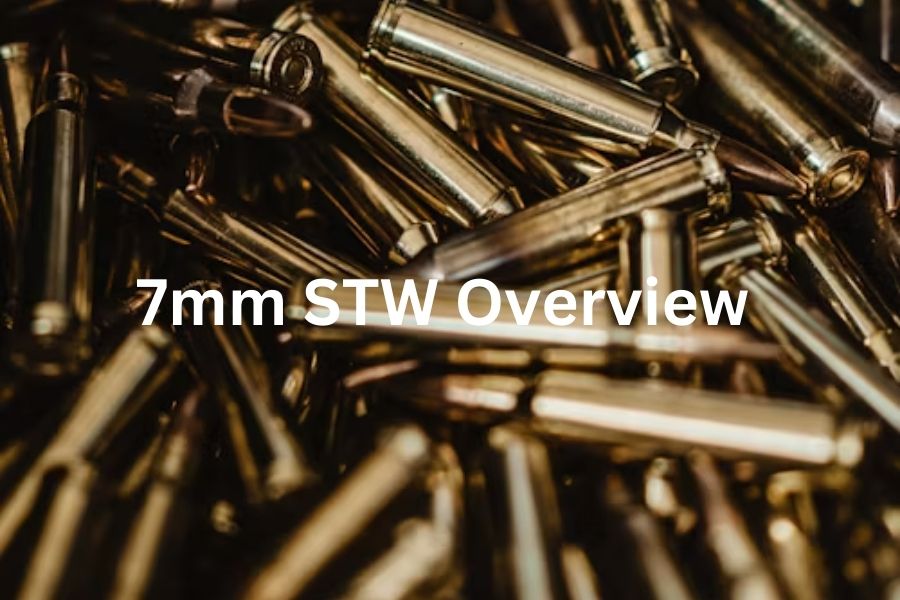The 7mm Shooting Times Westerner (STW) is a high-performance, long-range rifle cartridge designed to meet the demands of hunters and long-range shooters alike. Developed in the late 1970s, the 7mm STW has gained a reputation for its impressive velocity, flat trajectory, and ability to deliver substantial energy at extended distances. However, the 7mm STW, while still impressive, has died out in recent years. So in this article, we will take a look at the 7mm STW, its ballistics, and why it possibly died out.
Brief History of the 7mm Shooting Times Westerner
The 7mm STW was developed by Layne Simpson, a well-known gun writer and ballistician, in collaboration with the Shooting Times magazine and is specifically designed for long-range western hunting, hence its name.
It is based on the 8mm Remington Magnum case, necked down to accommodate 7mm (.284 caliber) bullets. Simpson’s goal was to create a cartridge that could outperform the 7mm Remington Magnum and it did, for some time (more on that later). While this cartridge was designed in 1979, it wouldn’t see production, and adoption, by large-scale companies till the 1990s and today is only produced by Federal Ammunition.
The 7mm STW quickly gained a following among hunters and long-range shooting enthusiasts who liked the idea of having a heavy-hitting cartridge that could reach out and hit targets well beyond 500 yards if needed.
Details of the 7mm Shooting Times Westerner
The 7mm STW is known for its ability to push 7mm bullets at high velocities which is why it was popular in the first place. It can handle bullet weights ranging from 120 to 175 grains, with 140 and 160 grains being the most common choices for big-game hunting.
The cartridge itself has an overall length of 3.6 inches (91.4 mm) and a case capacity of approximately 93.3 grains of water, making it capable of holding a significant powder charge needed to push bullets at such a high velocity.
In terms of cost, nowadays, 7mm STW ammunition can be more expensive than more common cartridges like the 7mm Remington Magnum, often ranging from $4 to $6 per round or more, depending on the manufacturer and bullet type. Reloading is popular among 7mm STW shooters, as it allows for fine-tuning the cartridge’s performance and can help reduce costs over time.
The reason for the downfall of the 7mm STW was not so dramatic. As new and improved loads came out for the 7mm Remington Magnum, many companies would drop the 7mm STW which could at one point be rechambered into a 7mm Remington Magnum barrel for only $60. Soon many forgot about the 7mm STW because the 7mm Remington Magnum was just as good if not better, it was also cheaper to shoot, and more companies were chambering rifles with it. So as time went on, the 7mm STW slowly faded into the past where it is only used by a select few today.
Here is a ballistics chart of 7mm STW with a 160-grain jacketed soft point bullet:
| range (YD) | drop (IN) | wind drift (IN) | velocity FPS | energy ft-lb |
| 0 | -1.5 | 0 | 3100 | 3414 |
| 50 | -0.3 | 0.1 | 3005 | 3208 |
| 100 | 0 | 0.5 | 2913 | 3014 |
| 150 | -0.8 | 1.2 | 2822 | 2829 |
| 200 | -2.6 | 2.2 | 2733 | 2653 |
| 250 | -5.6 | 3.5 | 2646 | 2487 |
| 300 | -9.9 | 5.2 | 2561 | 2329 |
| 350 | -15.5 | 7.1 | 2477 | 2179 |
| 400 | -22.4 | 9.4 | 2394 | 2036 |
| 450 | -30.9 | 12.1 | 2314 | 1902 |
| 500 | -41.1 | 15.2 | 2235 | 1774 |
Comparison of the 7mm STW to other cartridges
7mm STW vs. 7mm Remington Magnum
The 7mm Remington Magnum is one of the most popular and widely used 7mm cartridges in the world. When compared to the 7mm STW, the Remington Magnum is just as if not somewhat less powerful (depending on the load type).
However, you must consider that the 7mm STW is dying out, is far more expensive to shoot, and harder to find rifles chambered in it. So, overall, the better pick here is the 7mm Remington Magnum.
7mm STW vs. 300 Winchester Magnum
The 300 Winchester Magnum is another popular long-range cartridge, often favored for its versatility and power. When compared, you will notice that the 7mm STW shoots smaller and lighter bullets. At close-range, the 300 Win mag has significantly more energy. But at long-range, (400+ yards), the 7mm STW has slightly better retention of energy and therefore better ballistics.
7mm STW vs. 6.5 Creedmoor
The 6.5 Creedmoor has gained tremendous popularity in recent years, particularly in the precision shooting and hunting communities. Compared to the 7mm STW, the 6.5 Creedmoor is designed for lower recoil and precision at moderate ranges while the 7mm STW is designed for long-range without the worry of recoil.
The 7mm STW has more energy, flatter trajectories, less wind drift, and is just an overall ballistically superior cartridge. However, the 6.5 Creedmoor is a much smaller cartridge with 52 grains of H2O compared to 93 grains.
7mm STW vs. 270 Winchester Short Magnum
The 270 Winchester Short Magnum (WSM) is a modern short-action magnum cartridge that offers a balance of power and efficiency while being in a short-action cartridge. When compared to the 7mm STW, the 270 WSM is slightly less powerful, with lower muzzle velocities and a less flat trajectory. However, the 270 WSM is more efficient, burning less powder for comparable performance and generating less recoil. The 270 WSM is also cheaper and more popular.
Conclusion
The 7mm Shooting Times Westerner is a powerful and versatile cartridge that excels in long-range hunting and shooting applications. However, because of advancements in the 7mm Remington Magnum, the 7mm STW couldn’t hold on to its popularity for long. Thus it has been altogether replaced and will soon most likely stop being produced by ammo manufacturers.

